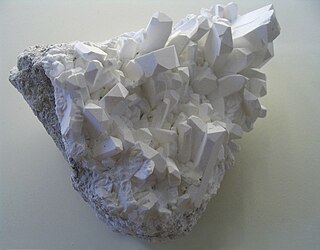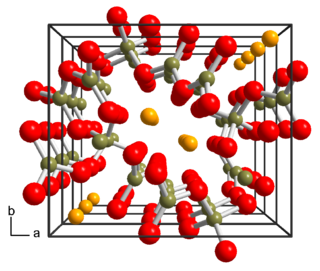 W
W20 Mule Team Borax is a brand of cleaner manufactured in the United States by The Dial Corporation, a subsidiary of Henkel. The product is named after the 20-mule teams that were used by William Tell Coleman's company to move borax out of Death Valley, California, to the nearest rail spur between 1883 and 1889.
 W
WThe Borate and Daggett Railroad was a 3 ft narrow gauge railroad built to carry borax in the Mojave Desert. The railroad ran about 11 miles (18 km) from Daggett, California, US, to the mining camp of Borate, three miles (4.8 km) to the east of Calico.
 W
WBorax, also known as sodium borate, sodium tetraborate, or disodium tetraborate, is a compound with formula Na2H4B4O9•nH2O or, more precisely, [Na•(H2O)+m]2 [B4O5(OH)2−4].
 W
WBoric acid, also called hydrogen borate, boracic acid, and orthoboric acid is a weak, monobasic Lewis acid of boron. However, some of its behaviour towards some chemical reactions suggest it to be tribasic acid in the Brønsted sense as well. Boric acid is often used as an antiseptic, insecticide, flame retardant, neutron absorber, or precursor to other chemical compounds. It has the chemical formula H3BO3 (sometimes written B(OH)3), and exists in the form of colorless crystals or a white powder that dissolves in water. When occurring as a mineral, it is called sassolite.
 W
WThe Death Valley Railroad (DVRR) was a 3 ft narrow gauge railroad that operated in California's Death Valley to carry borax with the route running from Ryan, California to the mines at Ryan C., located just east of Death Valley National Park, to Death Valley Junction, a distance of approximately 20 miles (32 km).
 W
WLithium borate, also known as lithium tetraborate is an inorganic compound with the formula Li2B4O7. A colorless solid, lithium borate is used in making glasses and ceramics.
 W
WLithium triborate (LiB3O5) or LBO is a non-linear optics crystal. It has a wide transparency range, moderately high nonlinear coupling, high damage threshold and desirable chemical and mechanical properties. This crystal is often used for second harmonic generation (SHG, also known as frequency doubling), for example of Nd:YAG lasers (1064 nm → 532 nm). LBO can be both critically and non-critically phase-matched. In the latter case the crystal has to be heated or cooled depending on the wavelength.
 W
WOrganotrifluoroborates are organoboron compounds that contain an anion with the general formula [RBF3]−. They can be thought of as protected boronic acids, or as adducts of carbanions and boron trifluoride. Organotrifluoroborates are tolerant of air and moisture and are easy to handle and purify. They are often used in organic synthesis as alternatives to boronic acids (RB(OH)2), boronate esters (RB(OR′)2), and organoboranes (R3B), particularly for Suzuki-Miyaura coupling.
 W
WMetaboric acid is the name for a family of inorganic compounds formed by the dehydration of boric acid. Metaboric acids are colourless solids with the empirical formula HBO2. There are two forms of metaboric acid, all are white solids. One form of metaboric acid is molecular, and the other forms are polymers.
 W
WPhenylmercuric borate is a topical antiseptic and disinfectant that is soluble in water, ethanol and glycerol.
 W
WFrancis Marion Smith was an American miner, business magnate and civic builder in the Mojave Desert, the San Francisco Bay Area, and Oakland, California.
 W
WSodium metaborate is a colorless solid chemical compound of sodium, boron, and oxygen with formula NaBO2. The formula can be written also as Na2O·B2O3 to highlight the relation to the main oxides of sodium and boron.
 W
WZinc borate is an inorganic compound, a borate of zinc. It is a white crystalline or amorphous powder insoluble in water. Its toxicity is low. Its melting point is 980 °C.